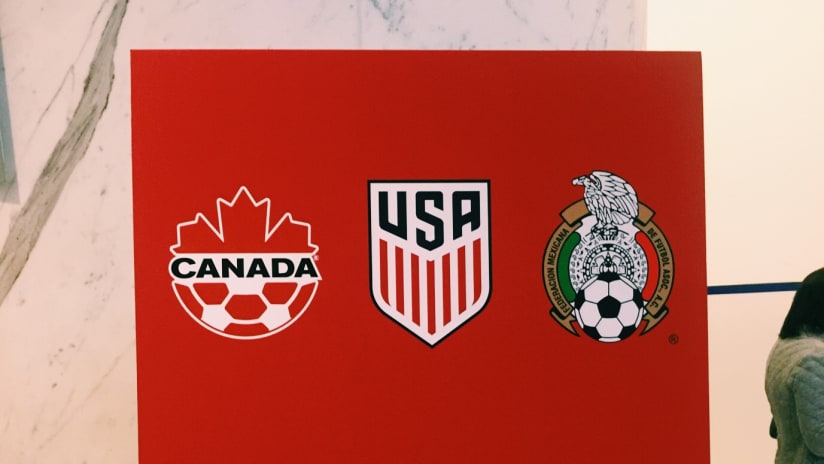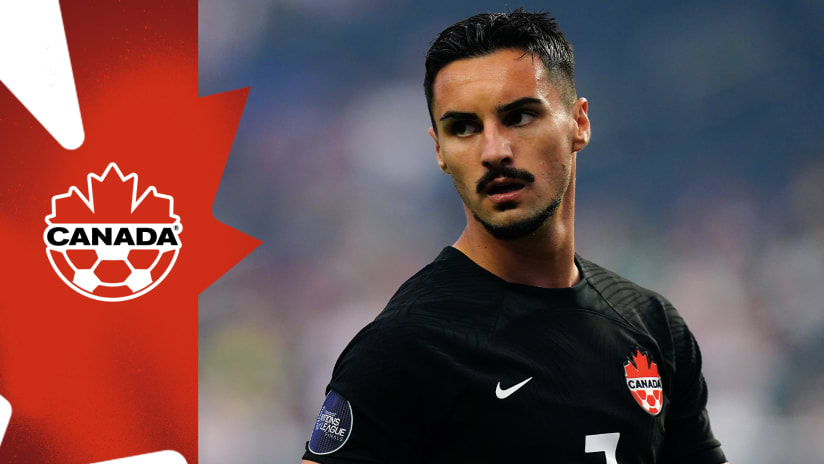At times during Monday afternoon’s historic World Cup bid announcement in downtown Manhattan, you could feel like you were, Slaughterhouse Five-style, un-stuck in time.
There was the setting – the One World Observatory, at One World Trade Center, whose complicated entry passages can seem almost like a version of the future, from the near past. In dark hallways punctuated by blue lights, flat video screens display smiling construction workers and executives extolling the virtues of the building.
The elevator ride up to the 102nd floor, the site of Monday’s press conference, married fantasy and reality. As the lift ascended or descended, the walls played an ultra-realistic, possibly vertigo-inducing animation of New York skyline history over the course of the ride.
Ok this animation alone in the elevator on the way down almost made me queasy 🤢 pic.twitter.com/tsatkQnYCD
— Arielle Castillo (@ariellec) April 10, 2017
Finishing the ride on the way way up, past unending lines of tourists behind a crowd-control rope, soccer media types wound up in a spotless, tiled atrium lit by sunlight coming through floor-to-ceiling glass with these views.
Chilled house-music piped in on the speakers and added to the vaguely spacey vibe. But then, it was time for business, a reminder it was 2017 after all, with an announcement billed as historic, between the heads of US Soccer, Canada Soccer, and the Mexican Football Federation. The official deal, it became clear within minutes, was the planned joint bid between the three countries to host the 2026 World Cup.
The news forced a consideration of seemingly all of North American soccer time at once. Such a partnership would have been unthinkable in the past. In the present, it seemed at first confusing, but then intriguing. And it begs an even more complex look into the 2026 near-future.
Indeed, the proposed World Cup spectacle for that year, on its surface – 48 teams, three countries – sounds bonkers. But it all shows an evolution for everyone involved, one in which CONCACAF’s biggest countries all have something to gain, to continue to further assert their global importance in the global game.
Most importantly, it shows that the region’s countries can continue to work together, even when it might seem, to outsiders following global news, like they might not. US Soccer president Sunil Gulati, for one, pointed out that the location for the announcement wasn’t chosen lightly.
“With Lady Liberty outside, you can truly see Canada and Mexico from here, as well as virtually every other nationality from here, in Manhattan, in New York,” he said. “The diversity of this country is extraordinary, and we look forward to welcoming the world.”
Victor Montagliani, the head of Canada Soccer and the president of CONCACAF, stressed similar ideals. "We've completely changed our mindset in this region to have a more [unified] CONCACAF vision," he said. "You also have three guys here who are sons of immigrants.... And nothing illustrates more what football brings to this world than, I think, our three backgrounds. That us three are standing here as presidents of federations of the countries that took in our families is a very powerful statement, and something I'm very proud of."
Political questions, of course, naturally followed – but all three federation heads, publicly, averred from specific policy discussion. Gulati, for his part, noted that US Soccer has “the full support of the government of the United States in this project. The President of the United States is fully supportive, and encouraged us to have this joint bid.”
That might raise some eyebrows for Mexico, which also needs no help growing or proving the popularity of the game within its borders. So Decio De Maria, head of Mexico’s FMF, stressed that the opportunity for Mexico was to welcome the world with open arms, to experience the joy brought by the sport.
“What I’m sure of is that our three countries will keep working together,” De Maria said in Spanish, “and that our societies will continue to enjoy what futbol really means. … The region will have won by inviting the world to enjoy with us what we love so much. I think that’s how you write a beautiful story.”
But it’s Canada’s involvement in particular, that probably points towards the biggest possibility for change. If the US hosting a World Cup in 1994 seemed preposterous, it could be argued that Canada’s already far ahead of where the former was at that point.
The Women’s World Cup there in 2015 proved a smashing success, and this bid would only prove the country’s ascendancy in the sport in a way that would have been unimaginable before the past decade or so. And consider that Canada, which hasn’t qualified for a World Cup since 1986, could possibly find an automatic berth in the tournament. There’s no doubt that seeing the country participate at this level will further whet the future appetite for the sport among kids now who are enjoying ascendant stars like Cyle Larin and potential future Canadian citizen Alphonso Davies.
(It can’t hurt that Toronto hosted last December’s MLS Cup to seat-rattling enthusiasm.)
For the US, the bid provides an opportunity to connect the past, present, and future all at once. Of course, there’s the “look how far we’ve come” storyline comparing the state of soccer in the country now to that of 1994. One only had to look at the press conference itself for proof – American soccer hero Alexi Lalas hosted, but now with a resume including big-time commentating on the international game.
There’s also no longer the past question of whether or not there are enough suitable US venues, or even cities where people would turn out. In fact, Gulati stressed, the idea is not to take on the typical World Cup project of spending money on new stadiums or infrastructure, but instead, to take advantage of “more venues” on the existing American sports landscape.
That means relatively new markets outside of the usual national-team-game circuit will be sure to enter the conversation and host major matches. “There’s an extraordinary impetus,” Gulati said, of spreading the matches around to prove the growth of the game in the US. “Another World Cup here would further that and do the same in Canada, and maybe Canada is where we were 20 years ago — and what a growth spurt there.”
There’s also a tantalizing look at the future of the US men’s national team in all of this. It’s a relatively safe bet that all three host countries will automatically qualify. But by then, will the US be able to prove they’re contenders beyond the group stage and Round of 16? We’ve got a half a generation, more or less, to discover new talents, and to develop a new crop of future veterans in the meantime. After all, as The New York Times' Andrew Das pointed out on Twitter, Christian Pulisic will still be in his 20s in 2026.
Will one of these countries finally make a World Cup final on their own territory? It’s a future that’s fun to imagine. But let’s not get ahead of ourselves. With the formal bid to be made, there’s plenty of organizing and logistics – plenty – to consider in the present. Whether you love or hate the idea, you’re going to want to watch how it all shakes out.
ExtraTime Radio Podcast

LISTEN: It's official! The United States, Canada and Mexico are joining forces to bring the World Cup back to CONCACAF, making their pitch for 2026 official on Monday at a press conference in New York City. The guys walk you through all the details (31:02), then give their takes on what would be an incredible event. Plus, everything you need to know about MLS Week 6 and David Beckham stories with former MLS MVP Mike Magee (47:45). Subscribe so you don't miss a show!













